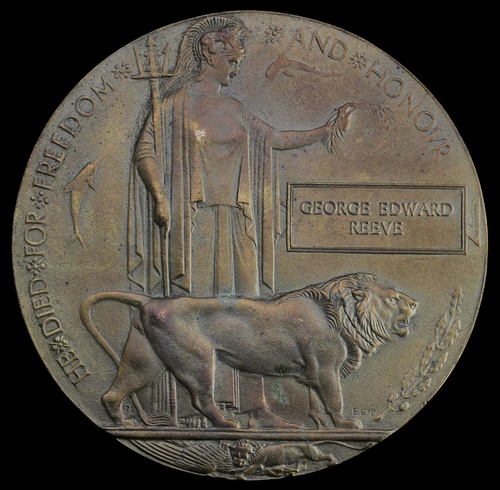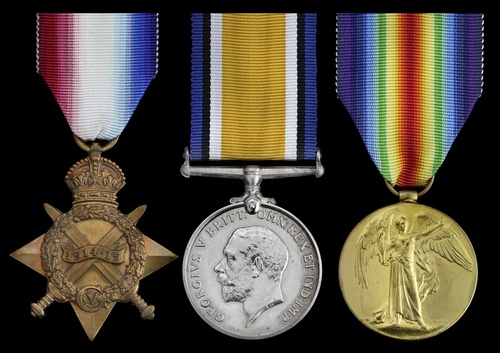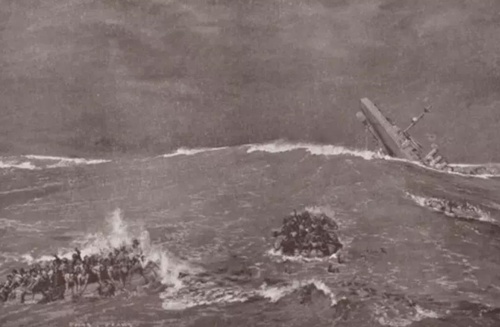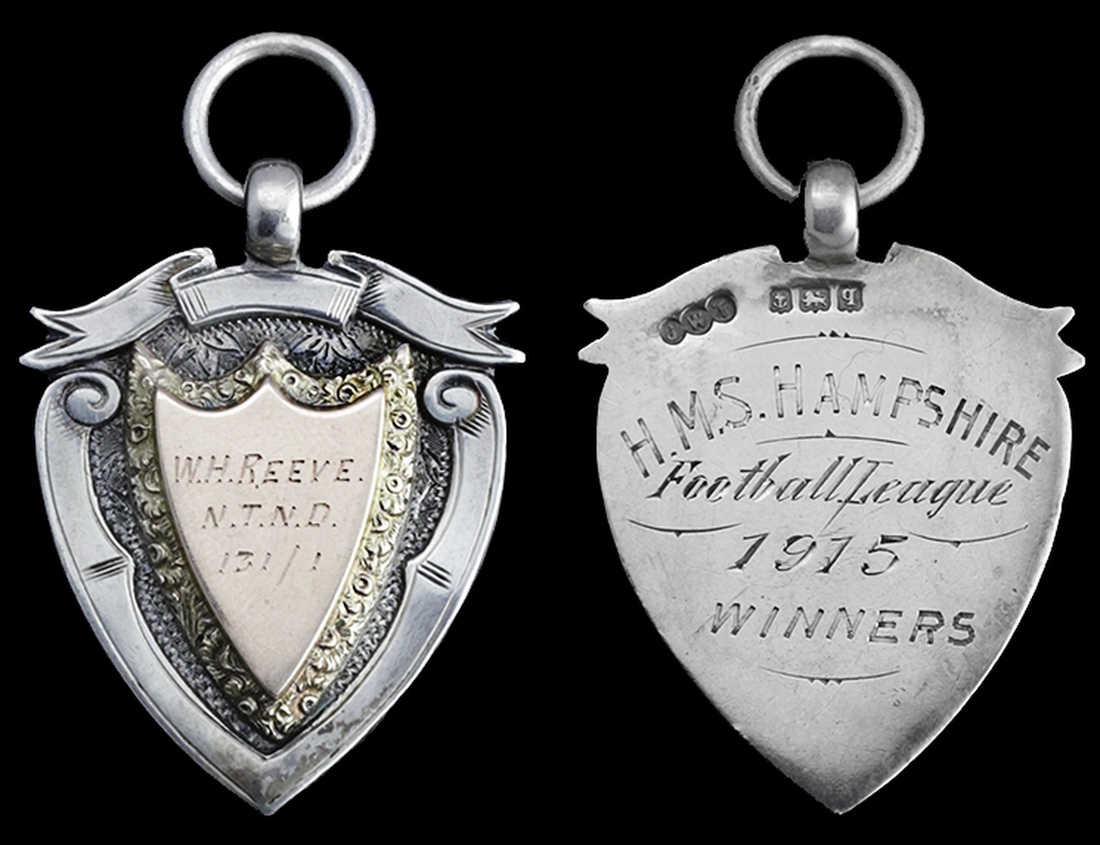Auction: 18003 - Orders, Decorations and Medals
Lot: 347
An extremely well-documented and highly emotive Great War casualty's group three awarded to Yeoman of Signals G. E. Reeve, Royal Navy, who, 'having had the good fortune to come off scot free' at Jutland, was drowned in heavy seas just a few days later, when famously H.M.S. Hampshire struck one of several mines laid by U-75 off the Orkneys
1914-15 Star (232867, G. E. Reeve, Y.S., R.N.); British War and Victory Medals (232867 G. E. Reeve, Y.S. R.N.), together with the recipient's Memorial Plaque (George Edward Reeve), and a football prize watch fob, the obverse engraved gold applique panel, 'W. H. Reeve, N.T.N.D. 131/1', and to reverse 'H.M.S. Hampshire, Football League, 1915 Winners', extremely fine (5)
George Edward Reeve was born in Wakefield, Yorkshire on 18 November 1877, the son of Edward and Margery Reeve. He worked for a short period as a clerk before entering the Royal Navy on his eighteenth birthday, much to his father's displeasure - even at such a young age, he felt that his son had thrown away his chance of making a success of his life; in 1910, George married Miss Martha Ellen Butterworth in Haywood, and they would soon have a daughter, Winifred, affectionately known as 'Winnie'.
According to Winnie's recollections - which are well documented - her father's early days in the Navy 'turned out to be very exciting'. Having enlisted as a Boy 2nd Class, George gained rapid advancement and became a Leading Signalman aboard H.M.S. Imperieuse on 1 July 1909. In the lead up to the Great War he served aboard the battleship Dreadnought and the cruiser Europa, before joining the Devonshire-class armoured cruiser Hampshire on the China Station at Wei Han Wei on 27 January 1914.
On 28 July 1914 Vice-Admiral Sir Martyn Jerram received a warning from the Admiralty that war was imminent and he ordered the Hampshire to leave its anchorage and head to sea. In a letter George compiled to his wife aboard the Hampshire on 2 August 1914, it is clear that confusion reigned:
'My Own Darling Wife,
I don't know exactly when I received your letter but it was just before we left Wei-hai-Wei. I told you in my last letter that there was something in the wind & I didn't know what it was. Well we had to come in & all ships had to complete with coal as quickly as possible & prepare at once for war. We had not the faintest idea who the war was going to be with. It took 3 days before all ships were ready & then we left Wei-hai-Wei for an unknown destination.'
The Hampshire was ordered to destroy the German radio station at Yap, but, owing to insufficient coal reserves she made for Hong Kong with the crew of the captured collier S.S. Elspeth. She subsequently was ordered to the Dutch East Indies where the hunt began for the German light cruiser Emden, which had been preying upon unsuspecting British shipping. It was following the sinking of the Emden on 9 November 1914 - by H.M.A.S. Sydney - that Hampshire undertook and a long period of escort work before returning to home waters for service with the Grand Fleet, via a refit at Gibraltar; she arrived in time to participate in the battle of Jutland on 31 May 1916, but was never actually engaged, firing four salvos at the German II Scouting Group which fell well short of their targets, in addition to shooting at illusory submarine periscopes throughout the day (Jutland: An Analysis of the Fighting, by John Campbell, refers).
The Hampshire returned to Scapa Flow, where her crew were each able to send a Post Office Telegraph to loved ones. George told Martha: 'Quite alright, inform Mother, George.' However, in a letter to his wife written that same day - the 3 June 1916 - it is clear that news of the British losses were beginning to affect him deeply:
'I am not going to attempt to give you details of the fight, you will probably learn much more from the newspapers than I can tell you dear. Then again, I haven't the heart to say very much at present, I have lost too many friends. The Queen Mary, Invincible & Black Prince are all Portsmouth ships & a good number of the signalmen are friends of mine.'
At about the same time as George put pen to paper, the Hampshire was detached from the Grand Fleet and was assigned the special duty of conveying Lord Kitchener and his staff to Russia. The series of defeats which had overwhelmed that country in 1915 made it imperative for a minister of high rank and influence to travel there and examine the situation on the spot; the great reputation which Kitchener had won, together with his knowledge of the U.K.'s potential to supply the Russians with munitions, singled him out as the man who could impart confidence with our Russian ally.
The Mission arrived at Scapa on the morning of 5 June 1916. The weather was extremely poor with a north-easterly gale; the voyage of Hampshire promised therefore to be unpleasant from the outset. At 4.45 p.m. she left Scapa and made for Archangel. The gale was so strong as to render the two slower escort destroyers useless for their purpose and, after about an hour of battling against the head sea, Captain H. J. Savill of the Hampshire ordered them to return to port. Alone and at limited speed, the Hampshire carried on, but she struck a mine at about 7.40 p.m. and sank by the bow within 15 minutes; a total of 737 men were drowned, including Lord Kitchener, all members of the Mission to Russia, and Yeoman of Signals George Reeve.
The next day, his wife Martha, unaware of the disaster which had befallen the Hampshire, wrote in reply to a letter recently received from George:
'Bradley Cottage,
New Hey,
Tuesday June 6th/16
My Dear George
I have just received your short note so am trying to get in a reply in the dinner hour. What a blessing you are safe and how thankful I am. I won't weary you with saying how it affected me and you will have enough on your mind & my worry is nothing compared with the sorrow it will have brought into hundreds of homes.
Thanks very much for sending the telegram. I could scarcely open it. I thought it was from the Admiralty saying something had happened to you, but when I read the good news I gradually recovered. I suppose you will send me a longer letter when you can spare the time … '
At the time of writing this letter, George was already dead and, on 15 November 1916, Martha received a letter from the Admiralty confirming that his body had been recovered from the sea and been buried on 20 July in the Naval Cemetery on the island of Hoy. The identification of his body was ascertained by means of enquiries made of his brother, Lance-Corporal H. Reeve of the 2/4th K.O.Y.L.I., whose regimental number and address appeared on a slip of paper found on the body. In June 1917, Martha received a second letter from the Admiralty, this time confirming the forwarding of William's effects; included upon the list of five items was '1 Football Medal'; see above and related correspondence confirming same.
In a letter written by George's daughter Winnie to the person to whom she passed the collection in 1983, she made some final personal observations. Of a cap tally, possibly one those included with the Lot, she said:
'I thought I would iron the creases out before I sent you the ribbon and then I realised that those creases would have been made by my dad as he tied the bow to make the ribbon fit his cap - my young dad, whom I don't remember, but whom you have brought to life for me.'
Sold with a large quantity of original documentation, including:
(i)
The recipient's Buckingham Palace memorial scroll in the name of 'Yeo. Sig. George Edward Reeve, H.M.S. Hampshire'.
(ii)
Three handwritten letters from George to his wife, written aboard H.M.S. Hampshire and dated 2.8.14, 23.5.16 and 3.6.16; together with the letter written by Martha a day after his death, and corresponding envelopes (4), the latter stamped 'Return to sender, Admiralty instructions'; two further letters from the Admiralty regarding the recovery of William's body, place of burial and return of effects, together with correspondence regarding his widow's pension, dated 20.3.17.
(iii)
Four photographs, the first of George as a child in naval uniform, the second a portrait image of him as a young man in uniform, the third a family photograph with Martha and Winnie as a baby, and the fourth of Martha as an elderly lady.
(iv)
Postcards (6), written by William to his fiancée, later wife, whilst serving aboard various ships. These include some rather interesting insights into places visited and people he has met:
'Hotel Haasje Damear,
Amsterdam,
8.5.1912.
Dear Nellie,
Am in luck again. Queen of Holland is paying a visit here, have seen her 4 times already. Am not impressed however. Would rather have my dear in Haywood that Q of H any day. People here however go mad about her and baby. Dad.'
(v)
Cap tallies (2), for the Royal Yacht and H.M.S. Hermes.
(vi)
Post Office telegraph informing his wife that he is safe following the battle of Jutland.
(vii)
A handwritten letter from Winnie to the custodian of the collection in 1983:
'I have nothing else left now, this is positively my last contribution to your George Edward Reeve collection. Perhaps I shall see you again in September in the Thursday afternoon class.'
(viii)
Considerable private research regarding the fate of the Hampshire; copied marriage certificate and R.N. service record; C.W.G.C. correspondence; colour photographs of William's grave; postcards of Lord Kitchener (3); newspaper cuttings; and a copy of The Loss of H.M.S. Hampshire and the death of Lord Kitchener, by 'A Survivor'.
Subject to 20% VAT on Buyer’s Premium. For more information please view Terms and Conditions for Buyers.
Sold for
£2,700











